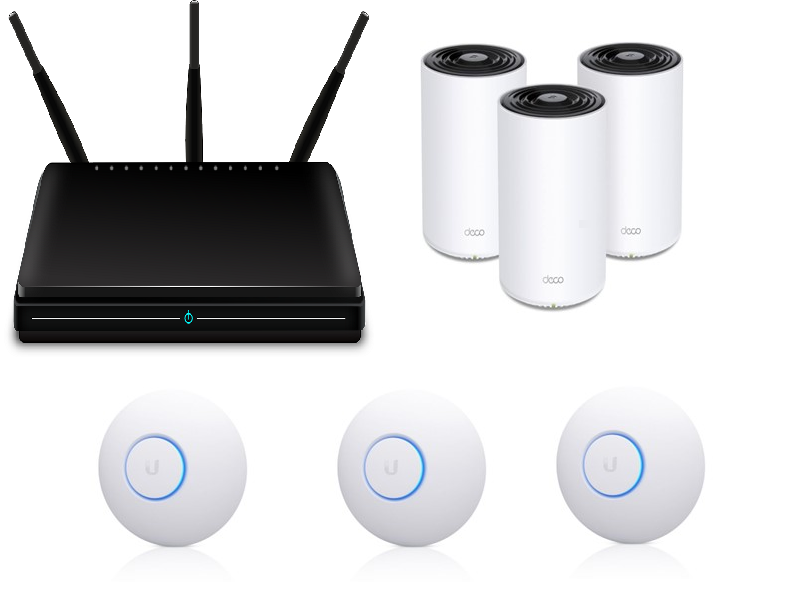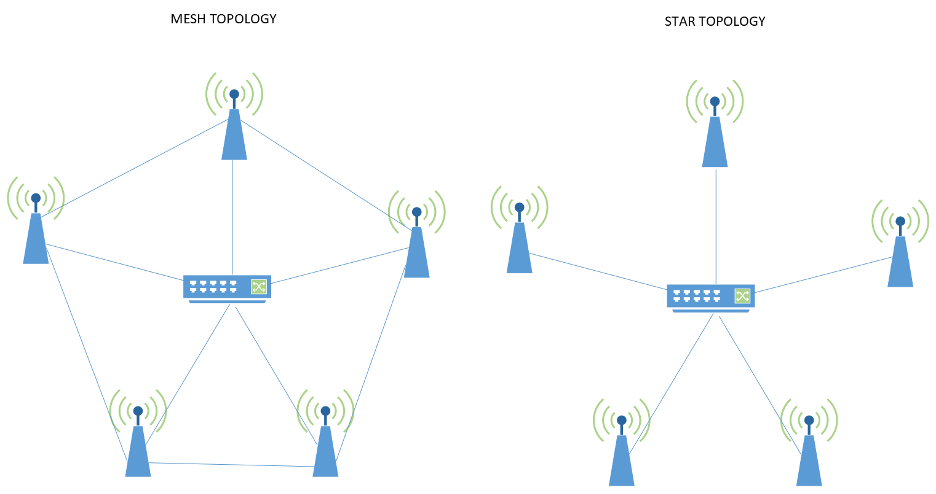Mesh Wi-Fi vs. Wireless Access Points: Which One Should You Choose?
In today’s highly connected world, a reliable Wi-Fi network is more important than ever. As smart devices proliferate in homes and workplaces, the need for consistent and expansive internet coverage follows suit. When it comes to maximizing your Wi-Fi performance, two popular solutions often come into play: Mesh Wi-Fi systems and traditional Wireless Access Points (WAPs). Each option presents its unique advantages and challenges, leading users to ponder which solution is best suited for their needs. Understanding the differences between the two is essential for creating a fast and reliable network that supports your technological ecosystem.
Mesh Wi-Fi systems have gained traction for their ability to blanket large areas with seamless connectivity. Comprising multiple nodes that work together to form a single network, mesh systems eliminate dead spots and provide robust coverage even in the most challenging environments. This technology thrives particularly in larger homes or spaces where obstructions significantly impact signal quality. In contrast, wireless access points extend existing networks by connecting via Ethernet cables, ensuring stable performance in designated areas. This versatility makes WAPs a popular choice for both residential and commercial applications, primarily when consistent signal strength in specific locations is required.
Deciding between Mesh Wi-Fi and wireless access points involves assessing your specific needs, space, and connectivity preferences. Factors such as the size of your area, the number of devices you connect, and your bandwidth requirements will significantly influence your choice. While mesh systems tout ease of setup and seamless roaming between nodes, WAPs offer controlled, wired connections for optimal performance in targeted spaces. Hence, understanding your unique environment and usage patterns will determine which solution may better serve you.
In this article, we will delve deeper into the characteristics, benefits, and downsides of both Mesh Wi-Fi and wireless access points. By comparing their features systematically, we aim to help you make an informed decision tailored to your connectivity needs. Whether you reside in a compact apartment or a sprawling estate, knowing the roles of these technologies will equip you to create a robust and efficient network that allows you to stay connected effortlessly.
Understanding Mesh Wi-Fi Technology
Mesh Wi-Fi technology has revolutionized the way we configure our home and office networks. At its core, a mesh system employs multiple devices, often referred to as nodes, that communicate with one another to deliver a unified and expansive Wi-Fi network. This design contrasts sharply with traditional routers, which serve a singular point of access. By evenly distributing coverage through a mesh system, homeowners can eliminate dead zones where Wi-Fi signals are weak or nonexistent, providing a seamless internet experience throughout the premises.
A key advantage of mesh networks is their ability to adapt to the unique characteristics of your home environment. Each node works collaboratively to ensure that users stay connected while roaming from one location to another. For example, if a user moves from a living room to a home office, their device will automatically connect to the nearest node with the strongest signal. This “hand-off” process is often smooth and nearly instantaneous, offering an experience akin to what users expect from wired connections. Moreover, modern mesh systems usually come equipped with advanced features such as automatic updates, parental controls, and built-in security protocols, providing enhanced functionality for families and individuals alike.
However, mesh Wi-Fi systems are not without their challenges. While they may offer superior coverage compared to traditional routers, users may experience slightly increased latency, primarily if multiple nodes must communicate through one another. Additionally, they typically require a more significant initial investment, as they consist of multiple devices rather than one central unit. For those with smaller spaces or straightforward networking needs, investing in a complete mesh system may seem excessive. It’s essential to weigh these pros and cons to determine if this technology aligns with your connectivity requirements.
Exploring Wireless Access Points
Wireless access points are a tried-and-true solution for expanding wireless connectivity in both residential and commercial networks. Unlike mesh networks, WAPs connect directly to a router via Ethernet cables, helping to extend the existing network’s reach. This approach ensures that users in remote areas of your property, like basements or distant attics, can still enjoy robust Wi-Fi connections without performance degradation associated with wireless signal strength. WAPs are particularly advantageous for businesses, as they can be specifically placed to meet the demands of high-traffic areas such as conference rooms or reception areas.
The flexibility of wireless access points is one of their most significant benefits. Administrators can choose where to place WAPs based on network demands, ensuring that high-bandwidth activities, such as streaming and gaming, receive the necessary coverage. Furthermore, since many WAPs are wired, they can deliver more consistent performance without the fluctuations that may occasionally occur in wireless setups. The capabilities of WAPs also extend to enabling robust security measures, VLANs, and guest networks, making them a great fit for complex networking environments.
One downside of wireless access points is their reliance on cabling, which may not be feasible in certain settings, particularly older homes or buildings where running Ethernet cables could be difficult or unsightly. Moreover, WAPs lack the seamless roaming features inherent to mesh networks. Users must manually switch connections when transitioning between access points, which can lead to dropped signals and interruptions, especially during high-bandwidth activities. Evaluating your specific needs and environment will help you determine whether the advantages of WAPs align with your connectivity goals.
Cost Considerations and Installation
When weighing the options between mesh Wi-Fi systems and wireless access points, cost is an important factor that can greatly influence your decision. Mesh systems often come as a package of multiple nodes and usually carry a higher upfront investment compared to single wireless access points. The cost can vary widely, depending on the technology, brand, and number of nodes included in the system. However, mesh systems provide built-in features and functionalities that may save users money on future upgrades or enhancements. For example, more extensible systems can adapt as households expand and additional devices come online, potentially negating the need for further investments in technology down the road.
In contrast, wireless access points may present a more budget-friendly option for those who require localized coverage. With WAPs, users can spend less on hardware while still achieving significant improvements to their Wi-Fi network in designated areas. WAPs’ reliance on Ethernet means an initial investment in cabling might be necessary, but this can result in a more stable and efficient overall connection. Additionally, the ease of installation for WAPs can vary depending on the existing network layout, as it may require more planning to determine optimal placements.
Ultimately, the total cost of ownership—which includes installation, equipment, and potential ongoing maintenance—should factor heavily into your decision-making process. For instance, a mesh Wi-Fi system may be more advantageous in larger homes needing extensive coverage, while wireless access points can satisfy homes with a more straightforward layout or businesses focusing on performance in specific areas. A thorough examination of your space, needs, and budget will help guide you towards the most suitable solution, ensuring that your investment yields enduring value.
Conclusion
In today’s digital landscape, making a choice between Mesh Wi-Fi and wireless access points can determine the quality of your connectivity for years to come. Both technologies offer unique advantages and drawbacks that cater to different environments and user demands. Mesh Wi-Fi systems excel in providing seamless coverage over large areas, making them an ideal choice for homes with numerous dead zones, whereas wireless access points offer robust solutions for localized coverage in both homes and commercial spaces. Understanding the capabilities and limitations of each option equips users to make knowledgeable decisions based on their specific needs and connectivity requirements.
When considering your network setup, it’s crucial to evaluate factors such as space configuration, the number of devices connected simultaneously, the lifestyle or workflows of inhabitants, and budgetary constraints. Mesh systems entice users with their straightforward setup and automatic network management capabilities, appealing to those who prefer convenience and flexibility. On the other hand, wired access points deliver consistent performance and enhanced security, which can be integral for businesses and serious users who prioritize reliability.
Ultimately, the decision on whether to choose mesh Wi-Fi or wireless access points should be informed by a comprehensive understanding of your unique situation and requirements. As technology continues to evolve and the demand for connectivity intensifies, individuals and organizations must remain vigilant in choosing solutions that can adapt to their changing needs. Whichever path you choose, investing in a reliable and effective network infrastructure will ensure you stay connected, empowered, and ready to embrace the digital future. The key is to weigh the pros and cons carefully, ultimately leading you to a decision that will set the stage for seamless connectivity and satisfaction in the years to come.




